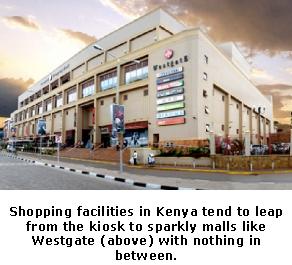 ReConnect Africa is a unique website and online magazine for the African professional in the Diaspora. Packed with
essential information about careers, business and jobs, ReConnect Africa keeps you connected to the best of Africa.
ReConnect Africa is a unique website and online magazine for the African professional in the Diaspora. Packed with
essential information about careers, business and jobs, ReConnect Africa keeps you connected to the best of Africa.


 Property makes up 5.3% of Kenya's GDP and has shown positive growth since 2001. Rachel Keeler takes a look why the sector continues to remain attractive to investors despite regulatory challenges and a difficult business environment.
Property makes up 5.3% of Kenya's GDP and has shown positive growth since 2001. Rachel Keeler takes a look why the sector continues to remain attractive to investors despite regulatory challenges and a difficult business environment.It's been a tough time recently for investors in Kenya: Tumbling equities and errant IPOs have destroyed wealth and kept many an asset manager up at night. Other investments have been eroded by rising inflation, even as the wider market struggles to recover from the global financial crisis and post-election violence.
For these reasons, Stanbic Investment Management Services (SIMS) spent its recent quarterly Business Club breakfast meeting discussing opportunities in Kenya's property market. Property makes up 5.3% of Kenya's GDP and has shown positive growth since 2001. A striking graph presented by Kenneth Kaniu, an investment manager at SIMS, contrasted Kenya's GDP taking a nose dive from 7.1% in 2007 to 1.7% in 2008 with real estate sector growth accelerating from around 3.5% to 3.6%. Property prices have gone up 30% from 2004 to 2009, according to a new (and long-awaited) property index put out by Hass Consult.
But investment vehicles for property assets remain underdeveloped in Kenya. The Capital Markets Authority (CMA) has been dragging its feet on new real estate investment trusts (REITs) regulations that would allow pension funds and asset managers to offer their clients a less chaotic, more liquid entry to the class. Pressure is on, especially, SIMS experts say, from small pension funds of less than KES500m that have too little capital to develop a diversified property portfolio on their own. Asset managers would also very much like to see the regulations come through, although a few of them expressed concerns that it could take until the end of 2010 to finalize the legislation.
In the meantime, SIMS researchers point out some key developments in the Kenyan market, which remains attractive to local investment clubs, property developers, corporates and Asian investors:
Despite input cost challenges, demand continues to far outpace supply in most real estate sectors, increasing market stability and potential returns for investors. SIMS highlights Kenya's archaic manual land registration system and cumbersome title transfer process as challenges to investors. The bureaucracy surrounding property development is also a burden. But the prospect of stable returns and the opportunity to beat inflation tend to outweigh these downsides, and will shine even more once the REITs option arrives.
Many experts have warned that a glut in office space is looming over Nairobi. Several large projects that began when demand was high are now set to come on stream as many businesses struggle with crisis fallout. However, Robert Bunyi, managing director of Mavuno Capital, says demand for top-end office space is robust while supply remains inadequate. Nairobi continues to attract large multi nationals hoping to tap growing markets in eastern and central Africa. And big companies already in the market can reportedly suffer from perpetual homelessness. Barclays' staff in Kenya has doubled over the past several years: "They're like hobos," Bunyi says – they can't seem to find an office big enough to hold them for long.
 Quality office space in small urban centers outside of Nairobi is virtually non-existent. Banks looking to expand their regional branch networks are especially keen to see this situation change.
Quality office space in small urban centers outside of Nairobi is virtually non-existent. Banks looking to expand their regional branch networks are especially keen to see this situation change.
Maina Mwangi at Knight Frank also points to areas around metropolitan Nairobi that are prime for development as the city expands: Kiambu, Kitengela, Athi River, and Kajiado to name a few. Mwangi thinks the rising cost of land will be good for development in these areas as it may inspire farm owners to sell portions of their plots. Other areas to watch are hotels, as Nairobi remains a business and conference hub, university housing, and retail space that Kenya's growing number of chain companies (Java, Uchumi, Nakumatt, KCB, etc.) will increasingly demand over the long term.
Finally, perhaps the most interesting real estate sub-sector in Kenya remains the ever-elusive low-end market. Knight Frank research presented by SIMS shows that low-end real estate has posted a market value increase of 200% since 1998, significantly higher than 170% for high-end properties, and 150% for those in the middle. Anyone on the street will tell you there is fantastic money to be made in slum housing and other low-income rentals. Demand is so high and supply so low that landlords can charge whatever they like. However, the security threats, lack of proper infrastructure and general chaos that surround these kinds of properties drive away up-market managers like Knight Frank.
SIMS researchers say the only way to unlock the low-end market is through government intervention. Property developers need incentives, and support must come from financiers to re-evaluate the mortgage potential of low-income earners. One thing to note, however, is the parallel demand for low-end retail space that comes along with the need for low-income housing.
Shopping facilities in Kenya tend to leap from the kiosk to sparkly malls like Westgate, with very little left to serve the huge demand in between. While finding the land on which to erect shopping centers anywhere in or around Nairobi remains difficult, tenants like Uchumi that have an interest in serving the low-end market would not be difficult to manage, and there is plenty of cash to be made on all sides.
